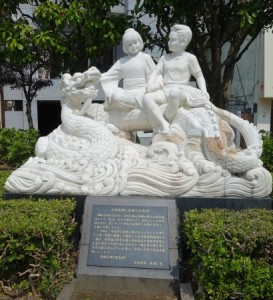
Nagasaki is a tourist friendly city. The Port Cruise Ship Welcoming Committee hands out easy to follow maps. During my 10 hours in port, I visited many noteworthy sites and got a taste of its spirit by strolling in Nagasaki. Most of the main attractions can be seen with proper planning and a good pair of walking shoes. This blog will recap my route and provide links back to the blogs that have additional facts and pictures.
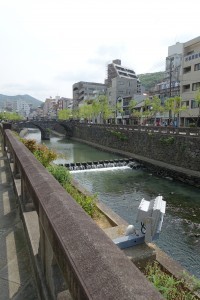
After visiting the focal point of Nagasaki World War II history, we went back to the tram station and boarded a blue streetcar. We disembarked at 36-Nishamano-Machi. Next, we crossed over the Nakashima River and walked along the narrow river.
The Nakashima River is a manmade canal that was built during the late 16th century. It was designed to flow through the center of the town. Due to its cultural and historic significance, the river was knicknamed “mother River.” At that time, Nagasaki was a major trading port with China and Portugal.
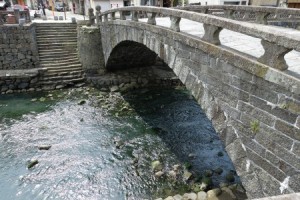
Fukuro Bridge dates back to the 17th century. Fukuro is derived from the original name of the surrounding neighborhood. It is considered one of the oldest stone arch bridges in Nagasaki.
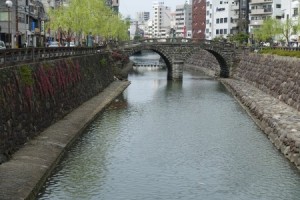
The Spectacles Bridge (Meganebashi) was built in 1634 by the Chinese Zen priest, Mozi. He wanted to provide easier access to the Kofukuji Temple. Even though the bridge has required periodic repairs, it remains the oldest Ming Chinese-style stone bridge in Japan. It is a Nationally Designated Important Cultural Property.
When you look toward the bridge at high tide, it appears to look like a pair of spectacles. Thus, the name refers to this image. Unfortunately, I did not visit during high tide.
Shortly thereafter, we crossed back over the bridge and continued for a few blocks until we found the Kofukuji Temple. Other blog postings will share information about Kofukuji Temple, Sofukuji Temple, and a few lesser known hidden treasures- Koei-zan Choshoji Temple,Daikoji Temple, and Kotaiji Temple. After visiting these temples, we found our way to Shinchi Chinatown.
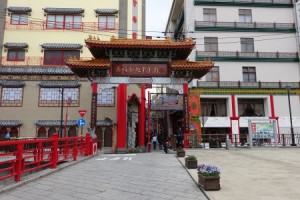
Today, one of the entrances to Nagasaki’s Shinchi Chinatown can be identified by the above structure. It is one of four vermilion-lacquered gates that were constructed by craftsmen and materials from Fuzhou, China. Each gate has a sculpture of one of the four directions gods. The Azure Dragon is on the east gate. The White Tiger is on the west gate. The Vermilion Bird is found on the south gate. The Black Tortoise can be seen on the north gate.
Nagasaki’s Chinatown has a long history and is considered one of the three largest in Japan.
From 1603-1868 (the Edo Period), Chinese and Dutch sailors and traders were frequent visitors to Nagasaki, Japan. The Dutch and Chinese traders were the only foreigners permitted to enter Japan for over two hundred years- 1639 to 1854.
These traders came to Nagasaki because it was considered an “open port.” The rest of Japan was closed off to foreigners in order to prevent Western influences and the spread of Christianity. As a result of this national isolation policy, the Chinese were relegated to designated parts of town. At its peak, approximately 10,000 Chinese from Fujian lived in Nagasaki. Today’s Chinatown is filled with a wide assortment of restaurants and shops.
Another landmark worth visiting is the Confucian Shrine and Historical Museum of China.
In 1859, the period of isolation ended and the port of Nagasaki was reopened along with Yokohama and Hakodate. This began a long overdue age of free trade with other nations. The western expats were corralled into settlement areas. It would be decades before non Japanese could live side-by-side with Japanese citizens.
Thomas Blake Glover, a Scottish merchant, was a significant force in the modernization of Japan’s economy. Today people can visit his garden and his renovated home at Glover Garden. This parklike setting includes Glover’s former residence, the oldest Western style house left in Japan as well as other structures.
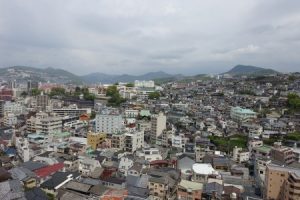
Initially, this was on our list of places to see. After hours of walking, we were tired, hungry and out of Japanese Yen. Fortuitously, we found a hidden elevator that took us up to the top of the hillside. From there we checked out the view before returning to the ship.
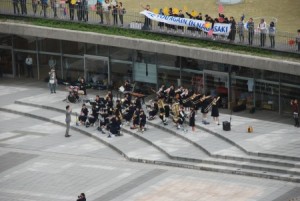
As our Celebrity Cruise ship left the harbor, we listened to a local school orchestra. It was a finishing touch to our outstanding visit.
Would I recommend visiting Nagasaki? Absolutely.
Related Posts
Sandra’s Bio
Sandra Bornstein is the author of MAY THIS BE THE BEST YEAR OF YOUR LIFE. It is available on Amazon. Sandra’s memoir highlights her living and teaching adventure in Bangalore, India. She is a licensed Colorado teacher who has taught K-12 students in the United States and abroad as well as college level courses. Sandra is married and has four adult sons. The memoir was a finalist in the Travel category for the 2013 Next Generation Indie Book Awards, the 2013 International Book Awards, the 2013 National Indie Book Excellence Awards, the 2013 USA Best Book Awards, and received an Honorable Mention award in the Multicultural Non-Fiction category for the 2013 Global ebook Awards.
Leave a Reply
You must be logged in to post a comment.